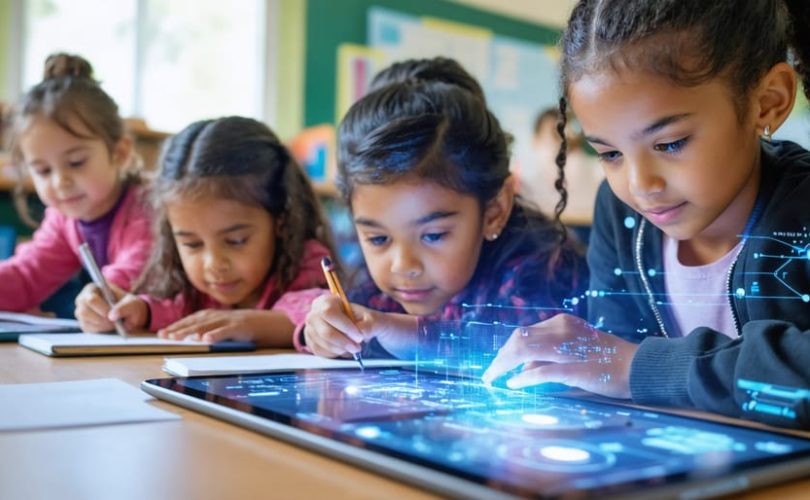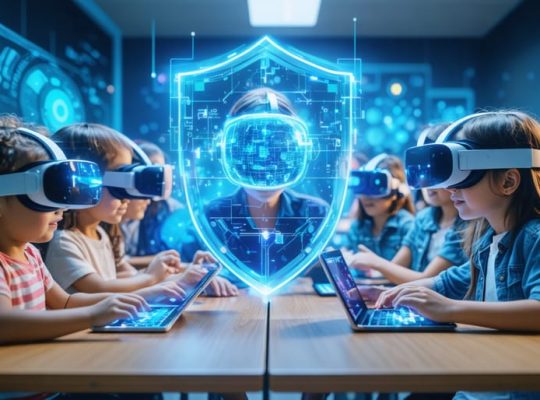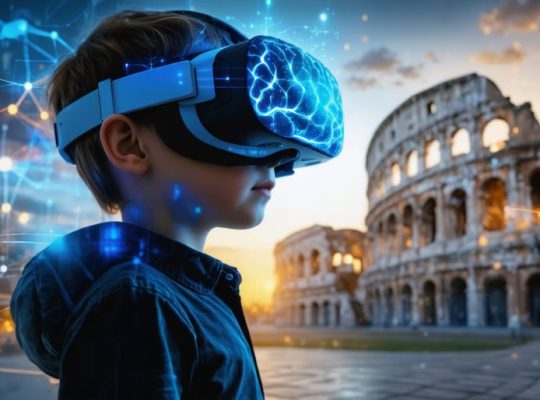Artificial intelligence is revolutionizing education in ways that both excite and concern parents and educators. As AI’s impact on digital learning continues to grow, we’re witnessing a fundamental shift in how children learn, interact with information, and develop critical thinking skills.
In classrooms across the globe, AI-powered tools are personalizing learning experiences, providing instant feedback, and helping teachers identify students’ unique needs with unprecedented precision. Yet this technological transformation also raises important questions about screen time, data privacy, and the preservation of human connection in education.
For parents and educators navigating this new landscape, understanding AI’s role in education isn’t just about embracing new technology – it’s about ensuring these powerful tools enhance rather than replace traditional learning methods. As we explore the intersection of artificial intelligence and education, we’ll examine how to harness AI’s potential while maintaining the essential human elements that make learning meaningful and effective.
This balanced approach to AI integration in education promises to create more inclusive, engaging, and effective learning environments for students of all abilities, while addressing the valid concerns of parents and educators who want to ensure technology serves their children’s best interests.
The Benefits of AI in Children’s Education
Personalized Learning Pathways
One of the most remarkable features of AI in education is its ability to create truly personalized learning experiences for each student. Unlike traditional one-size-fits-all teaching methods, AI-powered educational platforms can observe and analyze how individual students learn, process information, and respond to different types of content.
Sarah Thompson, a third-grade teacher in Boston, shares her experience: “Since implementing AI-assisted learning tools in my classroom, I’ve noticed that students who previously struggled are now thriving. The system adapts to their pace and presents information in ways that make sense to them.”
These intelligent systems track various learning indicators, including how quickly students complete tasks, which concepts they find challenging, and what teaching methods resonate best with them. For instance, if a student learns better through visual aids, the AI automatically incorporates more diagrams and videos into their lessons. For auditory learners, it might emphasize spoken explanations and interactive discussions.
The technology also adjusts the difficulty level of content in real-time, preventing both frustration from material that’s too challenging and boredom from lessons that are too easy. This dynamic adjustment helps maintain student engagement and confidence while ensuring steady progress.
Parents report seeing improved motivation in their children, as the personalized approach makes learning feel more achievable and enjoyable. The system provides immediate feedback and encouragement, helping students develop a growth mindset and take ownership of their learning journey.

Enhanced Engagement and Interactivity
Today’s AI-powered educational tools are transforming the way children learn by making education more engaging and interactive than ever before. These innovative technologies adapt to each student’s learning style, creating personalized learning experiences that keep children motivated and excited about their studies.
Take Sarah, a third-grade teacher in Boston, who introduced AI-powered math games in her classroom. “The difference in student engagement was immediate,” she shares. “Students who previously struggled with multiplication now eagerly compete in virtual math challenges, learning through play without even realizing it.”
These interactive tools include virtual science labs where students can safely conduct experiments, language learning apps that use speech recognition to help with pronunciation, and adaptive reading programs that adjust difficulty levels in real-time. The technology responds to each child’s progress, offering encouragement and additional support when needed.
Educational games powered by AI are particularly effective because they combine learning with entertainment. For instance, geography lessons come alive through virtual field trips, while history lessons transform into interactive storytelling adventures. These tools also provide immediate feedback, helping students understand and correct mistakes as they learn.
Parents and teachers report that these AI-enhanced learning experiences not only improve academic performance but also boost students’ confidence and willingness to tackle challenging subjects. The key is finding the right balance and using these tools as supplements to, rather than replacements for, traditional teaching methods.
Potential Concerns and Challenges

Screen Time and Digital Balance
As AI becomes increasingly integrated into educational settings, managing screen time effectively has become more crucial than ever. Dr. Sarah Chen, a child development specialist, emphasizes that “finding the right balance between digital learning and offline activities is essential for children’s overall well-being.”
Creating healthy boundaries around technology use doesn’t mean completely restricting access to AI-powered educational tools. Instead, it’s about establishing thoughtful routines and guidelines. For example, Jennifer Martinez, a middle school teacher in California, implements a “tech-free zone” during specific parts of the day, allowing students to engage deeply with hands-on learning activities and face-to-face interactions.
Consider these practical strategies for maintaining digital balance:
– Schedule regular breaks between AI-assisted learning sessions
– Encourage physical activity and outdoor time
– Set clear boundaries for device usage during homework
– Create designated tech-free spaces and times at home and in classrooms
– Monitor signs of digital fatigue or overexposure
Parents and educators should watch for signs that students might be spending too much time with technology, such as eye strain, difficulty sleeping, or decreased interest in non-digital activities. Mark Thompson, a parent of two elementary school students, shares, “We’ve found success with the 20-20-20 rule: every 20 minutes, look at something 20 feet away for 20 seconds.”
Remember that each child’s needs are different, and what works for one student may not work for another. The key is to remain flexible while maintaining consistent boundaries that support both educational growth and overall well-being.
Social Development Considerations
While AI brings remarkable educational benefits, we must carefully consider its impact on children’s social development and emotional learning. As Sarah Martinez, a child development specialist, notes, “Technology should complement, not replace, human interaction in education.”
Face-to-face interactions remain crucial for developing empathy, reading social cues, and building meaningful relationships. When children spend significant time interacting with AI systems, they might miss opportunities to practice these essential life skills. Parents and educators have observed that students who primarily engage with digital learning tools may struggle with in-person communication and collaborative activities.
However, AI can also support social-emotional learning when used thoughtfully. Interactive AI programs can help children practice social scenarios, recognize emotions, and develop conflict resolution skills in a safe, judgment-free environment. For example, some schools use AI-powered role-playing exercises that allow students to explore different social situations and their consequences.
To maintain healthy social development while incorporating AI in education, consider:
– Setting clear boundaries for screen time and AI tool usage
– Creating opportunities for group projects and peer interaction
– Using AI as a supplement to, not a replacement for, human teaching
– Encouraging regular face-to-face discussions about learning materials
– Monitoring children’s emotional responses to AI interactions
Dr. James Chen, an educational psychologist, emphasizes that “the key is finding the right balance. AI should enhance social learning experiences rather than isolate students from their peers.” By mindfully integrating AI while preserving meaningful human connections, we can help children develop both technical and social skills for their future success.
Supporting Healthy AI Integration
Creating a Balanced Learning Environment
Creating a balanced learning environment means thoughtfully combining traditional teaching methods with AI-powered tools. Dr. Sarah Chen, an educational psychologist, suggests starting with a 70-30 split, where AI supplements rather than replaces core teaching activities. “The human connection in education remains irreplaceable,” she explains, “but AI can enhance learning when used intentionally.”
Consider implementing these practical strategies in your classroom or home learning space:
Start with clear objectives for each learning session, determining whether AI tools will genuinely enhance the lesson. For instance, use AI for personalized practice exercises while maintaining face-to-face discussions for complex concept exploration.
Establish regular “tech-free” periods during learning time, focusing on hands-on activities, group discussions, and creative projects. These moments help develop crucial social and emotional skills that AI cannot replicate.
Integrate AI tools gradually, beginning with simple applications like interactive quizzes before moving to more advanced features. This approach helps both educators and students adjust comfortably to new technology while setting healthy digital boundaries.
Monitor student engagement and well-being regularly. Watch for signs of over-reliance on AI or decreased social interaction. Adjust the balance as needed, remembering that each student’s optimal mix of traditional and AI-assisted learning may differ.
Create opportunities for collaborative learning where students can use both AI tools and traditional methods to solve problems together. This hybrid approach helps develop digital literacy while maintaining essential social connections.

Monitoring and Supporting Progress
As AI becomes more integrated into education, it’s crucial to establish effective monitoring systems and support structures. Teachers and parents can work together in tracking students’ progress through AI-powered learning platforms while supporting digital well-being.
Regular check-ins with students help ensure they’re engaging meaningfully with AI tools rather than becoming overly dependent. Create a balanced schedule that alternates between AI-assisted learning and traditional methods, allowing children to develop both digital and conventional learning skills.
Dr. Sarah Chen, an educational psychologist, suggests: “Monitor not just academic progress, but also emotional responses to AI learning tools. Look for signs of engagement, frustration, or withdrawal, and adjust accordingly.”
Consider implementing these practical monitoring strategies:
– Set clear learning goals and track progress through AI analytics
– Schedule regular face-to-face discussions about the learning experience
– Document both achievements and challenges
– Maintain open communication between teachers, parents, and students
– Watch for signs of screen fatigue or decreased social interaction
Remember that each child adapts differently to AI learning tools. Some may need more guidance, while others quickly become independent learners. The key is maintaining a supportive environment that encourages questions and feedback.
Create regular opportunities for students to reflect on their AI learning experiences through simple surveys or group discussions. This feedback helps educators fine-tune the integration of AI tools while ensuring they truly serve students’ educational needs.
As we’ve explored throughout this article, AI is transforming education in remarkable ways, offering personalized learning experiences, innovative teaching tools, and enhanced accessibility for students of all abilities. While these advancements bring exciting opportunities, it’s crucial to remember that AI should complement, not replace, the human elements that make education meaningful.
Teachers remain irreplaceable in providing emotional support, nurturing creativity, and modeling social skills that are essential for children’s development. The key lies in finding the right balance – using AI to handle routine tasks and provide data-driven insights while preserving the warmth and connection of human interaction in the classroom.
For parents and educators moving forward, consider starting small with AI integration. Choose tools that align with your educational goals and regularly evaluate their impact on students’ learning and well-being. Remember that every child responds differently to technology, so maintain flexibility in your approach.
The future of education isn’t about choosing between traditional methods and AI – it’s about thoughtfully combining both to create enriching learning experiences. By staying informed, maintaining open dialogue with students, and prioritizing their social-emotional needs, we can harness AI’s potential while preserving the heart of education: human connection and growth.
Together, we can create learning environments that prepare our children for a technology-rich future while nurturing their uniquely human qualities and abilities.







